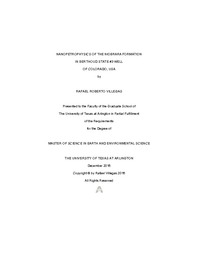| dc.description.abstract | The advent of new drilling and completion technologies over the past two decades has made unconventional shale reservoirs the focus of much of the oil and gas exploration and production throughout the United States. Despite large estimated reserves, unconventional reservoirs are typically characterized by low porosity and extremely low matrix permeability, partly accounting for the relatively low recovery rates seen, ranging from 10-15%. Increasing production from unconventional reservoirs requires an understanding of the reservoir’s nano-petrophysical properties including pore throat size distribution and edge accessible porosity. Furthermore, an understanding of the relationship between TOC, mineralogy, and pore throat distribution is critical in determining hydrocarbon storage potential and migration pathways, and ultimately recovery rates of the reservoirs.
Similar to many unconventional reservoirs which are prevalent throughout the United States, the Niobrara has been at the forefront of new innovations in hydrocarbon production. Well known as a tight gas reserve, the Niobrara Formation encompasses North Eastern Colorado, Wyoming, Montana, North Western Kansas, and Central Nebraska. The Niobrara was deposited during a major marine transgression of the western interior seaway during the Cretaceous and is characterized by calcareous hemipelagic beds of intervening chalks and marls.
After collecting core samples from 8 units within the Niobrara Formation in Berthoud State #3 Well, this research examined analyses of TOC, XRD, wettability, Mercury Injection Capillary Pressure (MICP), low-pressure nitrogen sorption, and fluid imbibition to determine pore geometry and connectivity within the formation. It was found that illite content plays a key role in pore size distribution and porosity, with a tendency for an increase in 2.8-5 nm pore throats and a decrease in porosity for samples with illite content above 10%. Other finding from wettability studies showed the samples were oil wet source rocks and imbibition studies produced results which suggested low pore connectivity. | |

